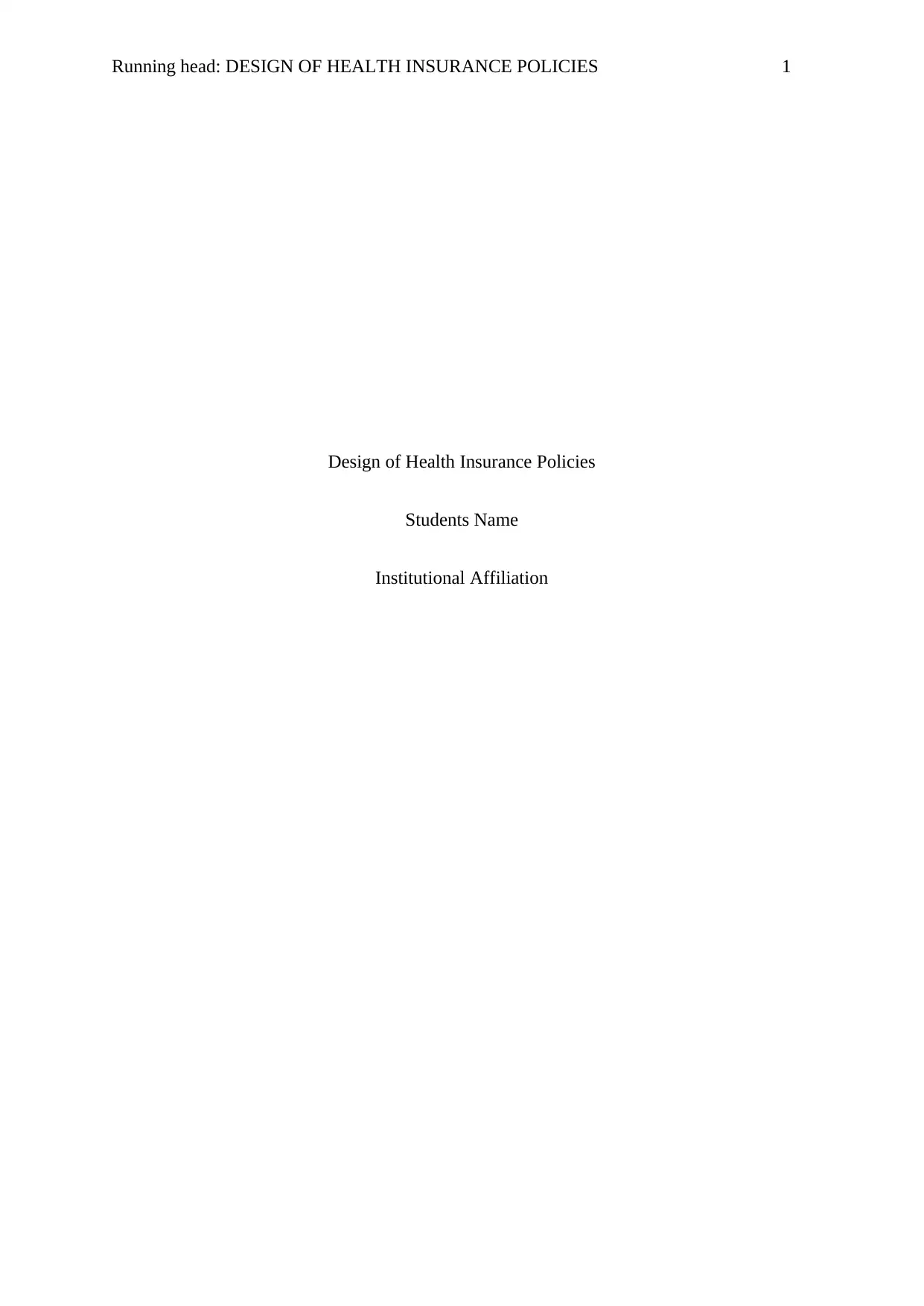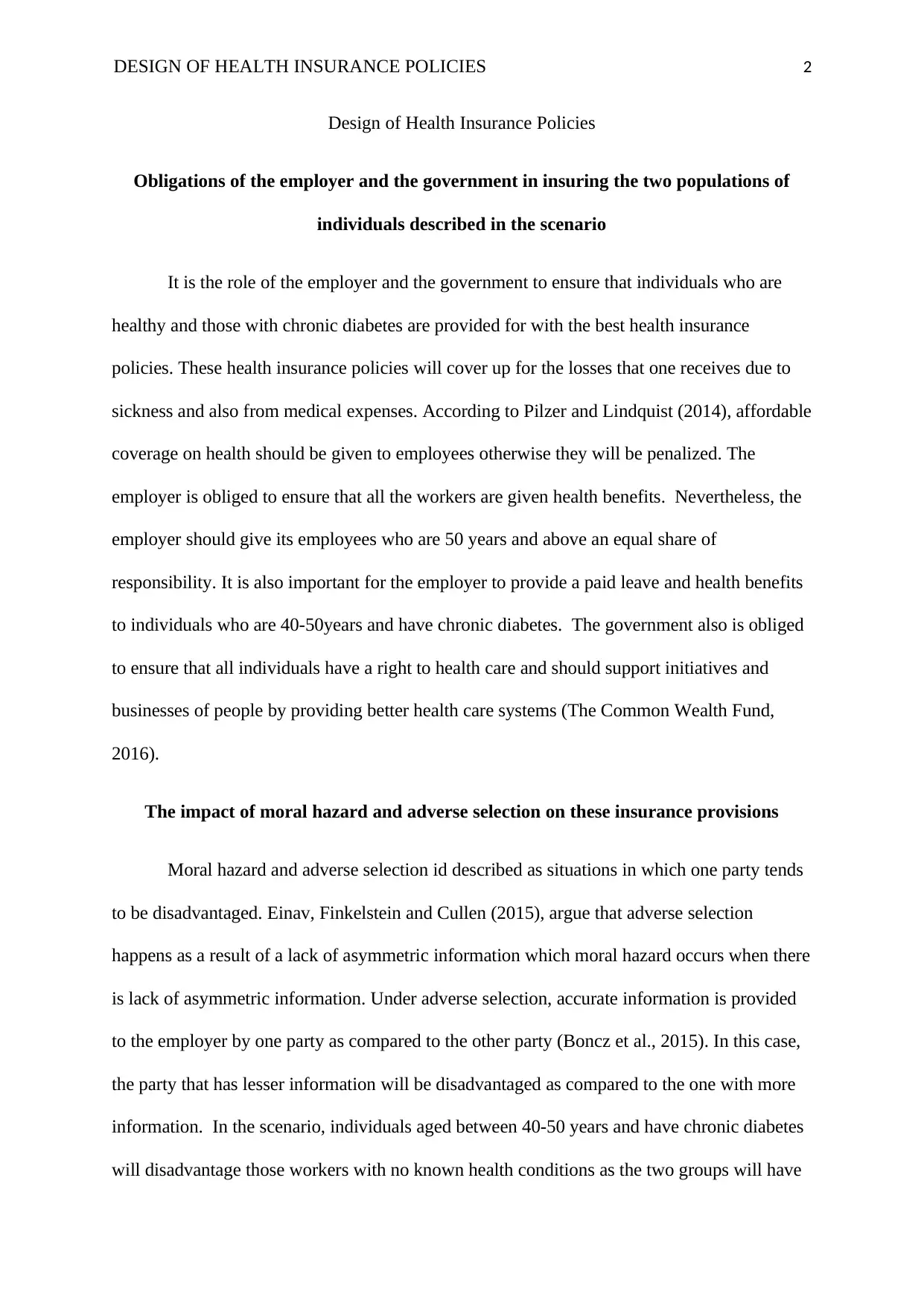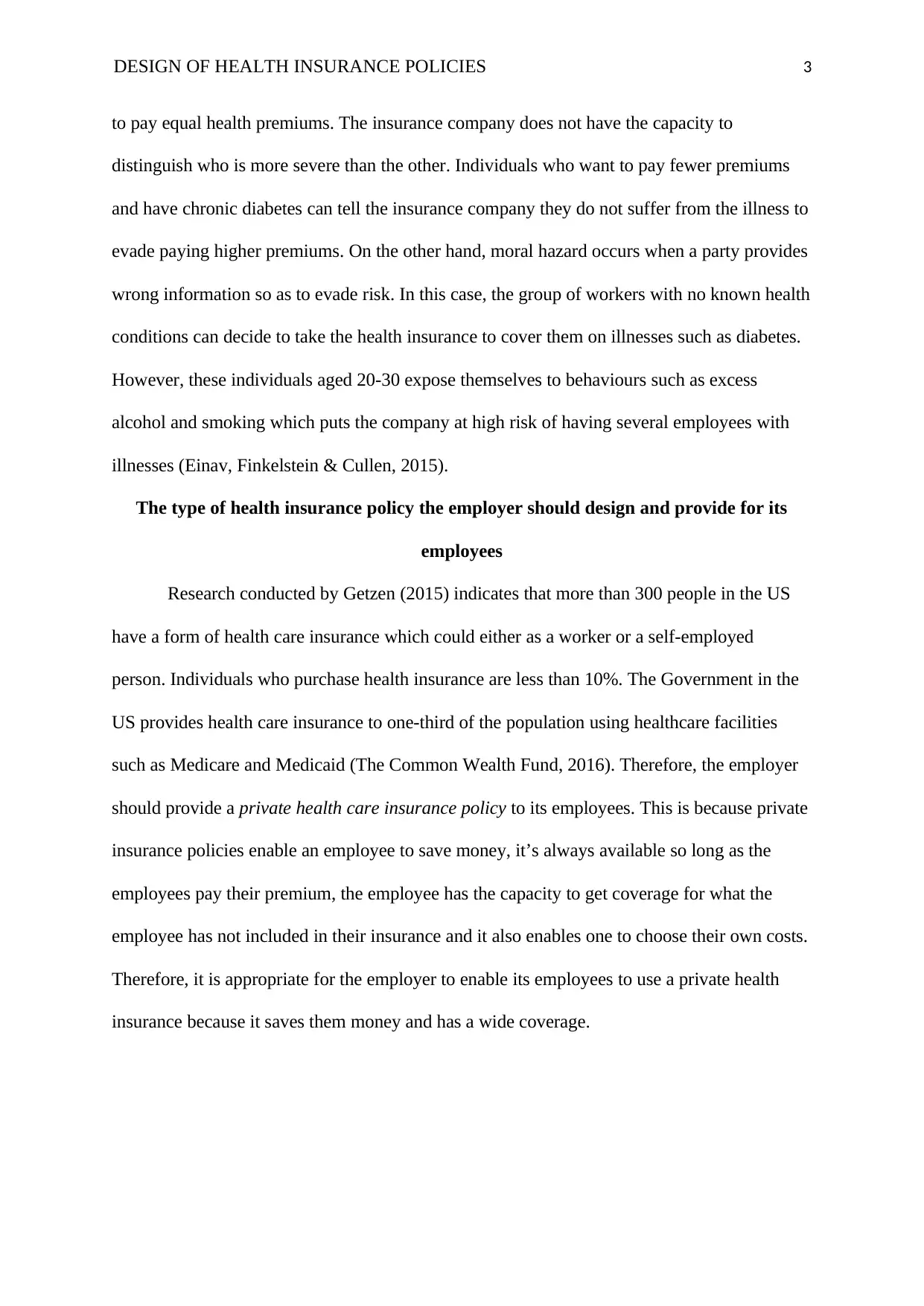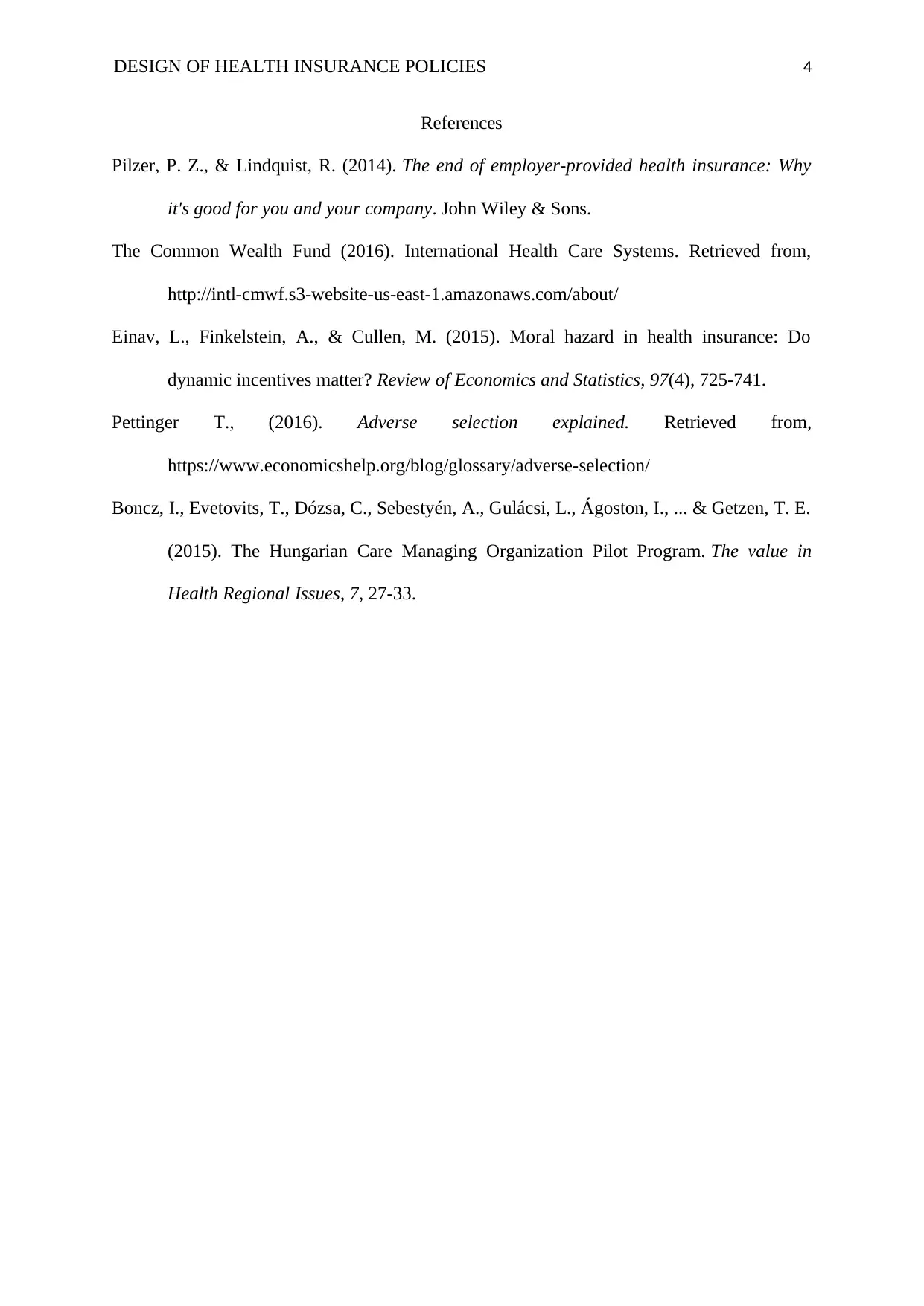Health Insurance Policy Design: Analyzing Obligations and Implications
VerifiedAdded on 2023/06/11
|4
|877
|87
Essay
AI Summary
This essay examines the design of health insurance policies, focusing on the obligations of employers and the government in ensuring adequate healthcare coverage for both healthy individuals and those with chronic conditions like diabetes. It delves into the impact of moral hazard and adverse selection on insurance provisions, highlighting how these issues can create imbalances in risk and cost distribution. The essay recommends that employers provide private health insurance policies to their employees, emphasizing the benefits of such policies in terms of cost savings and comprehensive coverage. The analysis draws upon research and real-world examples to support its arguments, providing a comprehensive overview of the complexities involved in health insurance policy design.

Running head: DESIGN OF HEALTH INSURANCE POLICIES 1
Design of Health Insurance Policies
Students Name
Institutional Affiliation
Design of Health Insurance Policies
Students Name
Institutional Affiliation
Paraphrase This Document
Need a fresh take? Get an instant paraphrase of this document with our AI Paraphraser

DESIGN OF HEALTH INSURANCE POLICIES 2
Design of Health Insurance Policies
Obligations of the employer and the government in insuring the two populations of
individuals described in the scenario
It is the role of the employer and the government to ensure that individuals who are
healthy and those with chronic diabetes are provided for with the best health insurance
policies. These health insurance policies will cover up for the losses that one receives due to
sickness and also from medical expenses. According to Pilzer and Lindquist (2014), affordable
coverage on health should be given to employees otherwise they will be penalized. The
employer is obliged to ensure that all the workers are given health benefits. Nevertheless, the
employer should give its employees who are 50 years and above an equal share of
responsibility. It is also important for the employer to provide a paid leave and health benefits
to individuals who are 40-50years and have chronic diabetes. The government also is obliged
to ensure that all individuals have a right to health care and should support initiatives and
businesses of people by providing better health care systems (The Common Wealth Fund,
2016).
The impact of moral hazard and adverse selection on these insurance provisions
Moral hazard and adverse selection id described as situations in which one party tends
to be disadvantaged. Einav, Finkelstein and Cullen (2015), argue that adverse selection
happens as a result of a lack of asymmetric information which moral hazard occurs when there
is lack of asymmetric information. Under adverse selection, accurate information is provided
to the employer by one party as compared to the other party (Boncz et al., 2015). In this case,
the party that has lesser information will be disadvantaged as compared to the one with more
information. In the scenario, individuals aged between 40-50 years and have chronic diabetes
will disadvantage those workers with no known health conditions as the two groups will have
Design of Health Insurance Policies
Obligations of the employer and the government in insuring the two populations of
individuals described in the scenario
It is the role of the employer and the government to ensure that individuals who are
healthy and those with chronic diabetes are provided for with the best health insurance
policies. These health insurance policies will cover up for the losses that one receives due to
sickness and also from medical expenses. According to Pilzer and Lindquist (2014), affordable
coverage on health should be given to employees otherwise they will be penalized. The
employer is obliged to ensure that all the workers are given health benefits. Nevertheless, the
employer should give its employees who are 50 years and above an equal share of
responsibility. It is also important for the employer to provide a paid leave and health benefits
to individuals who are 40-50years and have chronic diabetes. The government also is obliged
to ensure that all individuals have a right to health care and should support initiatives and
businesses of people by providing better health care systems (The Common Wealth Fund,
2016).
The impact of moral hazard and adverse selection on these insurance provisions
Moral hazard and adverse selection id described as situations in which one party tends
to be disadvantaged. Einav, Finkelstein and Cullen (2015), argue that adverse selection
happens as a result of a lack of asymmetric information which moral hazard occurs when there
is lack of asymmetric information. Under adverse selection, accurate information is provided
to the employer by one party as compared to the other party (Boncz et al., 2015). In this case,
the party that has lesser information will be disadvantaged as compared to the one with more
information. In the scenario, individuals aged between 40-50 years and have chronic diabetes
will disadvantage those workers with no known health conditions as the two groups will have

DESIGN OF HEALTH INSURANCE POLICIES 3
to pay equal health premiums. The insurance company does not have the capacity to
distinguish who is more severe than the other. Individuals who want to pay fewer premiums
and have chronic diabetes can tell the insurance company they do not suffer from the illness to
evade paying higher premiums. On the other hand, moral hazard occurs when a party provides
wrong information so as to evade risk. In this case, the group of workers with no known health
conditions can decide to take the health insurance to cover them on illnesses such as diabetes.
However, these individuals aged 20-30 expose themselves to behaviours such as excess
alcohol and smoking which puts the company at high risk of having several employees with
illnesses (Einav, Finkelstein & Cullen, 2015).
The type of health insurance policy the employer should design and provide for its
employees
Research conducted by Getzen (2015) indicates that more than 300 people in the US
have a form of health care insurance which could either as a worker or a self-employed
person. Individuals who purchase health insurance are less than 10%. The Government in the
US provides health care insurance to one-third of the population using healthcare facilities
such as Medicare and Medicaid (The Common Wealth Fund, 2016). Therefore, the employer
should provide a private health care insurance policy to its employees. This is because private
insurance policies enable an employee to save money, it’s always available so long as the
employees pay their premium, the employee has the capacity to get coverage for what the
employee has not included in their insurance and it also enables one to choose their own costs.
Therefore, it is appropriate for the employer to enable its employees to use a private health
insurance because it saves them money and has a wide coverage.
to pay equal health premiums. The insurance company does not have the capacity to
distinguish who is more severe than the other. Individuals who want to pay fewer premiums
and have chronic diabetes can tell the insurance company they do not suffer from the illness to
evade paying higher premiums. On the other hand, moral hazard occurs when a party provides
wrong information so as to evade risk. In this case, the group of workers with no known health
conditions can decide to take the health insurance to cover them on illnesses such as diabetes.
However, these individuals aged 20-30 expose themselves to behaviours such as excess
alcohol and smoking which puts the company at high risk of having several employees with
illnesses (Einav, Finkelstein & Cullen, 2015).
The type of health insurance policy the employer should design and provide for its
employees
Research conducted by Getzen (2015) indicates that more than 300 people in the US
have a form of health care insurance which could either as a worker or a self-employed
person. Individuals who purchase health insurance are less than 10%. The Government in the
US provides health care insurance to one-third of the population using healthcare facilities
such as Medicare and Medicaid (The Common Wealth Fund, 2016). Therefore, the employer
should provide a private health care insurance policy to its employees. This is because private
insurance policies enable an employee to save money, it’s always available so long as the
employees pay their premium, the employee has the capacity to get coverage for what the
employee has not included in their insurance and it also enables one to choose their own costs.
Therefore, it is appropriate for the employer to enable its employees to use a private health
insurance because it saves them money and has a wide coverage.
⊘ This is a preview!⊘
Do you want full access?
Subscribe today to unlock all pages.

Trusted by 1+ million students worldwide

DESIGN OF HEALTH INSURANCE POLICIES 4
References
Pilzer, P. Z., & Lindquist, R. (2014). The end of employer-provided health insurance: Why
it's good for you and your company. John Wiley & Sons.
The Common Wealth Fund (2016). International Health Care Systems. Retrieved from,
http://intl-cmwf.s3-website-us-east-1.amazonaws.com/about/
Einav, L., Finkelstein, A., & Cullen, M. (2015). Moral hazard in health insurance: Do
dynamic incentives matter? Review of Economics and Statistics, 97(4), 725-741.
Pettinger T., (2016). Adverse selection explained. Retrieved from,
https://www.economicshelp.org/blog/glossary/adverse-selection/
Boncz, I., Evetovits, T., Dózsa, C., Sebestyén, A., Gulácsi, L., Ágoston, I., ... & Getzen, T. E.
(2015). The Hungarian Care Managing Organization Pilot Program. The value in
Health Regional Issues, 7, 27-33.
References
Pilzer, P. Z., & Lindquist, R. (2014). The end of employer-provided health insurance: Why
it's good for you and your company. John Wiley & Sons.
The Common Wealth Fund (2016). International Health Care Systems. Retrieved from,
http://intl-cmwf.s3-website-us-east-1.amazonaws.com/about/
Einav, L., Finkelstein, A., & Cullen, M. (2015). Moral hazard in health insurance: Do
dynamic incentives matter? Review of Economics and Statistics, 97(4), 725-741.
Pettinger T., (2016). Adverse selection explained. Retrieved from,
https://www.economicshelp.org/blog/glossary/adverse-selection/
Boncz, I., Evetovits, T., Dózsa, C., Sebestyén, A., Gulácsi, L., Ágoston, I., ... & Getzen, T. E.
(2015). The Hungarian Care Managing Organization Pilot Program. The value in
Health Regional Issues, 7, 27-33.
1 out of 4
Your All-in-One AI-Powered Toolkit for Academic Success.
+13062052269
info@desklib.com
Available 24*7 on WhatsApp / Email
![[object Object]](/_next/static/media/star-bottom.7253800d.svg)
Unlock your academic potential
Copyright © 2020–2025 A2Z Services. All Rights Reserved. Developed and managed by ZUCOL.
